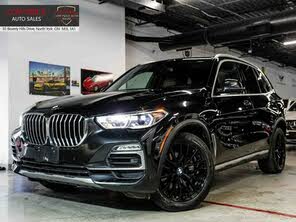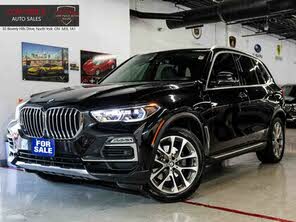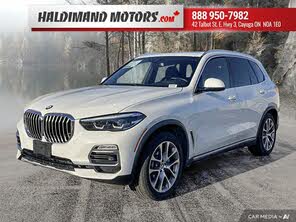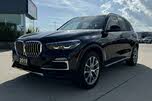2020 Toyota Sienna vs 2019 BMW X5
Overview | |
MSRP$60,700 | MSRP$29,715 |
Average price$42,993 | Average price$36,945 |
Listings60 | Listings70 |
Ratings & Reviews | |
User Reviews | User Reviews |
Expert reviews7.8 out of 10 | Expert reviews7.8 out of 10 |
Pros
| |
2019 BMW X5 Reviews SummaryThe BMW X5 redefined SUVs 20 years ago, leaning into the idea that you could have truck form and car function all in one package. In fact, BMW branded the original X5 as an SAV—a Sports Activity Vehicle—to help emphasize the fact that it drove as well as the company's famous sport sedans. And while that claim was a bit of an overreach, the original X5 did outperform its luxury SUV competitors on the road. Now in its fourth generation, BMW’s midsize crossover continues to deliver on that two-decade-old promise: The X5 delivers car-like handling in an SUV form. And while the 2019 X5 stretches 2.5 centimetres longer, 7.5 centimetres wider, and 2.5 centimetres taller than last year's model, you’d have to look closely to notice the differences. Most obvious is a new and bigger kidney grille with active shutters. It has already received flak for being “comically large,” though in our opinion, it seems proportional to the rest of the vehicle—enough to make us wonder if the grilles on previous iterations of the X5 were too small. Inside, you’ll find a redesigned interior with an updated version of the iDrive system and a suite of Level 2 autonomous technology that unfortunately leaves a lot to be desired. But that shouldn’t dissuade you from BMW’s revolutionary recreational vehicle, because there’s still a lot to love. | |
2020 Toyota Sienna Reviews SummarySince the second half of the 20th century, each decade has had a hot-topic family car, and, as we’ve noted in a number of reviews this year, the crossover is our current darling vehicle. Before the crossover, there were big, truck-based SUVs. Before that, there were station wagons. And for the past 35 years, there's always been the minivan. The Dodge Caravan has been widely considered the Patient Zero of the minivan segment. From there, seemingly everyone joined the party, including Toyota, Nissan, Ford, Chevy, GMC, Volkswagen, Oldsmobile, and more. Heck, even Mercury had a “Nautica Edition” version of the Villager. The minivan was king once, the crossover is king now, and some other type of vehicle will likely dominate in the near future. But in all this, the 7- and 8-passenger minivans will always represent the ultimate in versatility. The crossover is an image-forward fad with a dash of usability, but the minivan continues to prove itself as the pinnacle of practicality. The 2020 Toyota Sienna is neither the newest nor flashiest minivan out there, but when you absolutely need space for people and gear, there’s nothing better. Additionally, as of 2020 the Sienna is the only minivan to offer all-wheel drive (AWD), which is something specifically desired by many car buyers. | |
Popular Features & Specs | |
Engine3.0L 335 hp I6 | Engine3.5L 296 hp V6 |
Drive TrainAWD | Drive TrainFWD |
Seating Capacity7 | Seating Capacity2 |
Horsepower335 hp @ 5500 rpm | Horsepower296 hp @ 6200 rpm |
MPG City20 | MPG City19 |
MPG Highway26 | MPG Highway26 |
Engine | |
Engine Name3.0L 335 hp I6 | Engine Name3.5L 296 hp V6 |
Torque330 lb-ft @ 1500 rpm | Torque263 lb-ft @ 4700 rpm |
Horsepower335 hp @ 5500 rpm | Horsepower296 hp @ 6200 rpm |
DrivetrainAWD | DrivetrainFWD |
Fuel Economy | |
MPG City20 | MPG City19 |
MPG Highway26 | MPG Highway26 |
Interior | |
Seating Capacity7 | Seating Capacity2 |
Key Features | |
Navigation SystemStandard | Navigation System |
Sunroof/MoonroofStandard | Sunroof/Moonroof |
Safety | |
Front Crash Overall4 | Front Crash Overall4 |
Side Crash Overall5 | Side Crash Overall5 |
Dimensions & Capacity | |
Cargo Space33.9 cu ft | Cargo Space |
Curb Weight4813 lbs | Curb Weight4375 lbs |
Height69.0 in | Height68.9 in |
Length194.3 in | Length200.2 in |
Width87.3 in | Width78.1 in |
Wheelbase117.1 in | Wheelbase119.3 in |
Maximum Payload849 lbs | Maximum Payload |
Number of doors4 | Number of doors4 |
Maximum Towing Capacity7209 lbs | Maximum Towing Capacity |
Standard Towing Capacity6603 lbs | Standard Towing Capacity |
Overview | ||
MSRP | $60,700 | $29,715 |
Average price | $42,993 | $36,945 |
Listings | ||
Ratings & Reviews | ||
User reviews | ||
Expert reviews | 7.8 out of 10Read full review | 7.8 out of 10Read full review |
Pros & cons | Pros
| |
Summary | The BMW X5 redefined SUVs 20 years ago, leaning into the idea that you could have truck form and car function all in one package. In fact, BMW branded the original X5 as an SAV—a Sports Activity Vehicle—to help emphasize the fact that it drove as well as the company's famous sport sedans. And while that claim was a bit of an overreach, the original X5 did outperform its luxury SUV competitors on the road. Now in its fourth generation, BMW’s midsize crossover continues to deliver on that two-decade-old promise: The X5 delivers car-like handling in an SUV form. And while the 2019 X5 stretches 2.5 centimetres longer, 7.5 centimetres wider, and 2.5 centimetres taller than last year's model, you’d have to look closely to notice the differences. Most obvious is a new and bigger kidney grille with active shutters. It has already received flak for being “comically large,” though in our opinion, it seems proportional to the rest of the vehicle—enough to make us wonder if the grilles on previous iterations of the X5 were too small. Inside, you’ll find a redesigned interior with an updated version of the iDrive system and a suite of Level 2 autonomous technology that unfortunately leaves a lot to be desired. But that shouldn’t dissuade you from BMW’s revolutionary recreational vehicle, because there’s still a lot to love. | Since the second half of the 20th century, each decade has had a hot-topic family car, and, as we’ve noted in a number of reviews this year, the crossover is our current darling vehicle. Before the crossover, there were big, truck-based SUVs. Before that, there were station wagons. And for the past 35 years, there's always been the minivan. The Dodge Caravan has been widely considered the Patient Zero of the minivan segment. From there, seemingly everyone joined the party, including Toyota, Nissan, Ford, Chevy, GMC, Volkswagen, Oldsmobile, and more. Heck, even Mercury had a “Nautica Edition” version of the Villager. The minivan was king once, the crossover is king now, and some other type of vehicle will likely dominate in the near future. But in all this, the 7- and 8-passenger minivans will always represent the ultimate in versatility. The crossover is an image-forward fad with a dash of usability, but the minivan continues to prove itself as the pinnacle of practicality. The 2020 Toyota Sienna is neither the newest nor flashiest minivan out there, but when you absolutely need space for people and gear, there’s nothing better. Additionally, as of 2020 the Sienna is the only minivan to offer all-wheel drive (AWD), which is something specifically desired by many car buyers. |
Video | ||
Popular Features & Specs | ||
Engine | 3.0L 335 hp I6 | 3.5L 296 hp V6 |
Drive Train | AWD | FWD |
Seating Capacity | 7 | 2 |
Horsepower | 335 hp @ 5500 rpm | 296 hp @ 6200 rpm |
MPG City | 20 | 19 |
MPG Highway | 26 | 26 |
Engine | ||
Engine Name | 3.0L 335 hp I6 | 3.5L 296 hp V6 |
Torque | 330 lb-ft @ 1500 rpm | 263 lb-ft @ 4700 rpm |
Horsepower | 335 hp @ 5500 rpm | 296 hp @ 6200 rpm |
Drivetrain | AWD | FWD |
Fuel Economy | ||
MPG City | 20 | 19 |
MPG Highway | 26 | 26 |
Interior | ||
Seating Capacity | 7 | 2 |
Key Features | ||
Navigation System | Standard | |
Sunroof/Moonroof | Standard | |
Safety | ||
Front Crash Overall | 4 | 4 |
Side Crash Overall | 5 | 5 |
Dimensions & Capacity | ||
Cargo Space | 33.9 cu ft | |
Curb Weight | 4813 lbs | 4375 lbs |
Height | 69.0 in | 68.9 in |
Length | 194.3 in | 200.2 in |
Width | 87.3 in | 78.1 in |
Wheelbase | 117.1 in | 119.3 in |
Maximum Payload | 849 lbs | |
Number of doors | 4 | 4 |
Maximum Towing Capacity | 7209 lbs | |
Standard Towing Capacity | 6603 lbs | |

By: CarGurus + AI
At CarGurus, our team of experienced automotive writers remain at the heart of our content operation, conducting hands-on car tests and writing insightful guides that are backed by years of industry experience. To complement this, we are harnessing AI to make our content offering more diverse and more helpful to shoppers than ever. To achieve this, our AI systems are based exclusively on CarGurus content, ratings and data, so that what we produce is both unique to CarGurus, and uniquely helpful to car shoppers.









































